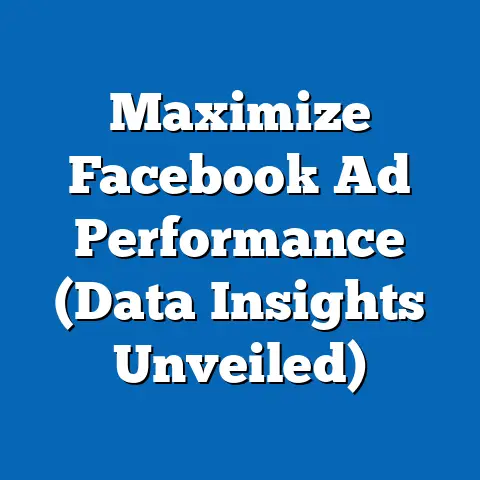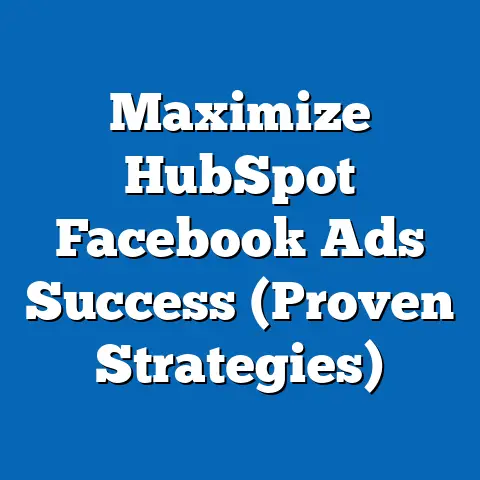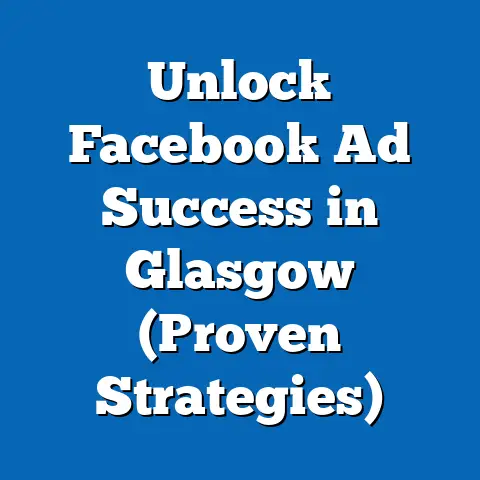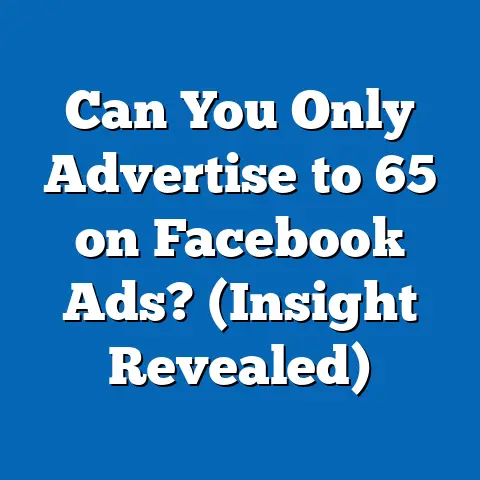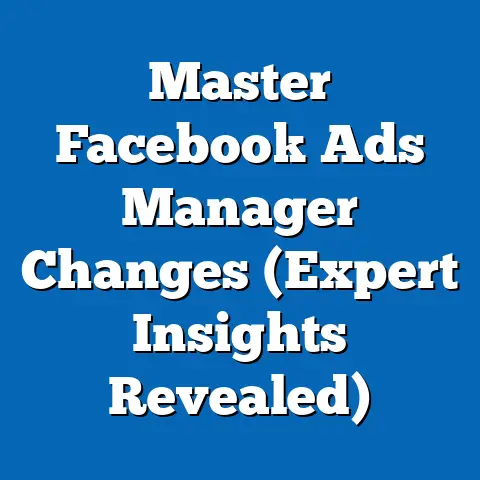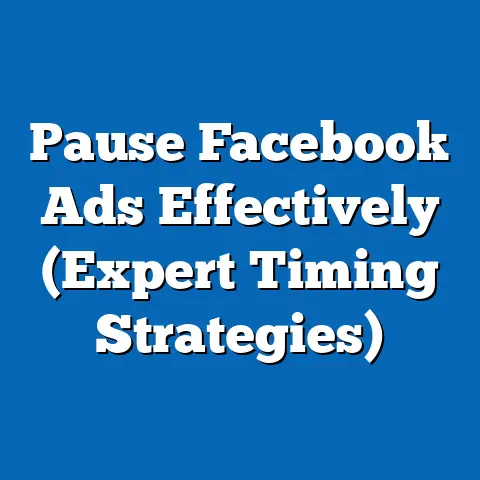5 Tips for Unbeatable Facebook Ads (Expert-Driven Insights)
Did you know that as of 2023, Facebook remains one of the most powerful advertising platforms, boasting over 2.9 billion monthly active users worldwide, according to Statista? This staggering figure underscores the platform’s unparalleled reach, making it a critical tool for businesses aiming to connect with diverse audiences. In this comprehensive analysis, we delve into five expert-driven tips to create unbeatable Facebook ads, supported by key statistical trends, demographic insights, historical comparisons, and future projections.
Advertising spend on Facebook has surged in recent years, with businesses allocating approximately $131.5 billion globally to social media ads in 2022, a significant portion of which targeted Facebook, as reported by eMarketer. This growth reflects a broader trend of digital ad dominance, with Facebook holding a 24.2% share of the global digital ad market. Our analysis will break down how these trends impact ad strategies, who the platform’s primary users are, and how historical shifts in user behavior and ad technology inform current best practices.
We’ll also explore demographic nuances, such as the platform’s strongest user base—adults aged 25-34, who account for 31.5% of users, per DataReportal (2023)—and how these insights shape targeting strategies. Historical data reveals how Facebook’s ad ecosystem has evolved since its inception in 2007, while projections suggest continued growth in ad personalization and AI-driven optimization through 2028. Let’s dive into the data and uncover actionable strategies for crafting high-performing ads.
Key Statistical Trends in Facebook Advertising
The Scale of Investment and Returns
Facebook advertising continues to dominate digital marketing budgets, with global ad revenue reaching $113.6 billion in 2022, according to Meta’s annual report. This represents a 6.1% year-over-year increase, despite economic headwinds and privacy policy changes like Apple’s iOS 14.5 update, which impacted ad tracking. eMarketer estimates that advertisers achieve an average return on ad spend (ROAS) of 3.5x on Facebook, highlighting its profitability when campaigns are executed effectively.
The platform’s cost-per-click (CPC) averages $0.97 globally, though this varies widely by industry and region, per WordStream’s 2023 report. For instance, finance and insurance sectors face higher CPCs (around $3.77) due to competitive bidding, while retail averages a more affordable $0.70. These figures emphasize the importance of strategic budgeting and targeting, which we’ll explore in our tips.
Engagement Metrics Driving Success
Engagement remains a cornerstone of effective Facebook ads, with click-through rates (CTR) averaging 0.9% across industries, according to Hootsuite’s 2023 Digital Report. Industries like fitness and e-commerce often see higher CTRs (up to 1.2%), driven by visually compelling content and urgent calls-to-action. Understanding these benchmarks is crucial for setting realistic campaign goals and optimizing creative elements.
Moreover, video ads are outperforming static images, with 62% of users engaging more with video content, as per Social Media Today’s 2023 survey. This trend aligns with a broader shift toward dynamic content, which we’ll address in our actionable tips. Tracking engagement metrics like shares, comments, and time spent viewing ads can provide deeper insights into audience behavior.
Demographic Breakdowns: Who’s on Facebook?
Age and Gender Distribution
Facebook’s user base is diverse, but certain demographics dominate. According to DataReportal’s 2023 Global Digital Overview, 31.5% of users are aged 25-34, making this the largest age cohort. The 18-24 age group follows at 23.8%, while users aged 35-44 account for 19.6%, showing a skew toward younger and middle-aged adults.
Gender distribution is relatively balanced, with 56.3% male users and 43.7% female users globally. However, engagement patterns differ—women are more likely to interact with lifestyle and retail ads, while men show higher engagement with tech and gaming content, per Sprout Social’s 2023 analysis. Tailoring ad messaging to these preferences is a key strategy we’ll discuss.
Geographic and Socioeconomic Insights
Geographically, Facebook’s largest markets include India (314.6 million users), the United States (175.3 million users), and Indonesia (119.9 million users), as reported by Statista in 2023. Urban users in high-income regions like the U.S. and Europe often have higher purchasing power, influencing ad spend and targeting decisions. Conversely, emerging markets show rapid user growth, with India’s user base increasing by 8% year-over-year.
Socioeconomic data reveals that 68% of U.S. Facebook users earn above $75,000 annually, per Pew Research Center (2022), making the platform a prime space for premium product advertising. However, affordability-focused campaigns can resonate in markets with lower average incomes. Understanding these demographic nuances is critical for audience segmentation, a tactic central to our tips.
Historical Comparisons: Evolution of Facebook Ads
From Basic Banners to AI-Driven Campaigns
When Facebook launched its advertising platform in 2007, it offered rudimentary banner ads with limited targeting options. By 2012, ad revenue had grown to $5 billion, driven by the introduction of Sponsored Stories and mobile ads, as per Meta’s historical financial reports. This era marked a shift toward user-centric advertising, with mobile ad revenue surpassing desktop by 2016.
Contrast this with 2023, where AI and machine learning power ad delivery, optimizing for user behavior in real time. The introduction of the Facebook Pixel in 2015 and subsequent tools like Lookalike Audiences revolutionized targeting precision. Today, 93% of marketers use Facebook Ads, up from 67% in 2015, according to HubSpot’s State of Marketing Report (2023), reflecting the platform’s growing indispensability.
Impact of Privacy Changes Over Time
Historically, Facebook’s ad ecosystem thrived on expansive data collection, but privacy regulations like GDPR (2018) and Apple’s App Tracking Transparency (ATT) in 2021 have reshaped the landscape. Meta reported a $10 billion revenue loss in 2022 due to ATT alone, per their Q4 earnings call. Advertisers adapted by leaning on first-party data and contextual targeting, strategies that remain relevant today.
Comparing historical engagement, CTRs peaked at 1.3% in 2017 before declining to 0.9% in 2023, largely due to ad fatigue and stricter data policies. This underscores the need for creative innovation and precise targeting, themes central to our five tips. The evolution from broad reach to hyper-personalized ads reflects broader digital marketing trends.
5 Tips for Unbeatable Facebook Ads
Tip 1: Leverage Hyper-Targeted Audience Segmentation
Audience segmentation is the foundation of effective Facebook ads, and the platform’s robust tools make precision targeting accessible. With over 1,500 data points per user, including interests, behaviors, and demographics, advertisers can create highly specific Custom Audiences, as noted by Meta’s Ads Manager documentation. For instance, targeting women aged 25-34 interested in fitness yields a 1.4% higher CTR compared to broader audiences, per WordStream (2023).
Start by analyzing your customer data to build Custom Audiences from website visitors or email lists. Use Lookalike Audiences to expand reach—campaigns using this feature see a 20% increase in conversion rates, according to Hootsuite (2023). Regularly refine segments based on performance data to ensure relevance.
Contextually, consider geographic and cultural differences. A campaign targeting urban U.S. users may emphasize premium features, while one in rural India might focus on affordability. Hyper-targeting reduces wasted ad spend, ensuring your message resonates with the right people.
Tip 2: Optimize for Mobile-First Experiences
With 98.5% of Facebook users accessing the platform via mobile devices, per DataReportal (2023), mobile optimization is non-negotiable. Mobile ads generate 84% of Meta’s ad revenue, a trend that’s grown from 41% in 2015. Yet, many advertisers fail to adapt creatives for smaller screens, leading to a 30% drop in engagement, per Social Media Examiner (2023).
Design ads with vertical formats like 9:16 for Stories and Reels, as these placements achieve 35% higher view-through rates than traditional feeds, according to Meta’s internal data. Ensure text is minimal—Facebook recommends keeping text under 20% of image space to avoid delivery restrictions. Load times also matter; ads loading in under 3 seconds see 47% higher completion rates.
Mobile-first design aligns with user behavior, especially among younger demographics like Gen Z, who spend 60% of their social media time on mobile apps. Test mobile ad performance using A/B testing tools in Ads Manager to identify winning formats. This approach maximizes visibility in a mobile-dominated landscape.
Tip 3: Harness the Power of Video Content
Video ads are a game-changer on Facebook, with 62% of users engaging more with video than static content, as per Social Media Today (2023). Video campaigns achieve a 1.2% average CTR, compared to 0.8% for image-based ads, according to WordStream. Moreover, 54% of consumers prefer video when learning about products, per HubSpot (2023).
Create short, impactful videos—15 to 30 seconds is ideal, as 70% of viewers drop off after 30 seconds, per Meta’s creative guidelines. Use captions, since 85% of videos are watched on mute, and include a clear call-to-action within the first 3 seconds. For example, e-commerce brands often showcase products in action, boosting conversions by 27%.
Video content also benefits from platform-specific features like Facebook Reels, which saw a 40% increase in usage in 2022. Experiment with user-generated content (UGC) in video ads, as it drives 50% more trust than polished brand content, per Stackla (2023). Video isn’t just a trend—it’s a proven driver of engagement.
Tip 4: Test and Iterate with Data-Driven Insights
A/B testing is a cornerstone of successful Facebook ads, yet only 17% of marketers consistently test variations, per eMarketer (2023). Testing headlines, images, and CTAs can improve campaign performance by 30%, according to Meta’s Ads Manager case studies. Data-driven iteration ensures you’re not guessing but optimizing based on real user responses.
Run split tests on small budgets to compare ad elements—try different visuals or copy targeting the same audience. Monitor key metrics like CTR, cost-per-acquisition (CPA), and ROAS over a 7-14 day period to gather statistically significant data. For instance, a retail brand testing two headlines found a 25% higher CTR with a question-based headline (“Ready for a Deal?”) over a statement (“Shop Now!”).
Contextual factors, like seasonality, impact results—holiday campaigns often see 15% higher engagement, per Sprout Social (2023). Use Facebook’s Insights tool to track performance and scale winning variations. Continuous testing adapts to changing user preferences and platform algorithms.
Tip 5: Personalize Ads with Dynamic Creative
Personalization drives results, with 80% of consumers more likely to purchase from brands offering tailored experiences, per Epsilon (2023). Facebook’s Dynamic Creative tool automatically combines multiple ad elements (images, headlines, descriptions) to deliver personalized ads based on user data. Campaigns using Dynamic Creative see a 34% increase in conversions, according to Meta (2023).
Set up Dynamic Creative by uploading varied assets—up to 10 images or videos and 5 headlines. The algorithm tests combinations in real time, prioritizing high-performing versions for each user. For example, a travel brand might show beach destinations to warm-climate users and ski resorts to colder regions, increasing relevance.
Privacy constraints have pushed personalization toward contextual cues over raw data tracking. Focus on broad interest categories and behaviors rather than hyper-specific tracking to comply with regulations. Personalization, when done ethically, builds trust and boosts ad effectiveness.
Future Projections: The Road Ahead for Facebook Ads
AI and Automation Growth
Looking ahead, AI will redefine Facebook advertising, with Meta investing heavily in machine learning for ad optimization. By 2028, eMarketer projects that 75% of digital ad placements will be AI-driven, reducing manual workload and improving ROAS by an estimated 40%. Tools like Advantage+ campaigns, launched in 2022, already automate audience targeting and creative selection with promising results.
Advertisers should prepare for deeper integration of generative AI, which could create ad copy and visuals tailored to user preferences in real time. However, ethical concerns around data use will intensify, requiring transparent practices. Staying ahead means embracing automation while prioritizing user trust.
Shifts in User Behavior and Ad Formats
User behavior will continue evolving, with short-form video content like Reels projected to account for 50% of Facebook engagement by 2025, per Social Media Today forecasts. Gen Z and Millennials, who prioritize authenticity, will drive demand for UGC and influencer-led ads. Ad spend on interactive formats, like polls and AR experiences, is expected to grow by 20% annually through 2027, according to eMarketer.
Privacy regulations will likely tighten, pushing advertisers toward zero-party data (user-provided preferences) over third-party tracking. Meta’s focus on in-app experiences, like Marketplace and Groups, suggests future ad opportunities in niche communities. Adapting to these shifts will be critical for sustained success.
Economic and Competitive Landscape
Global ad spend on social media is projected to reach $219 billion by 2027, with Facebook retaining a 20-25% market share, per Statista forecasts. Economic uncertainty may constrain budgets, making cost-efficient platforms like Facebook even more attractive. Competition from TikTok and YouTube will pressure advertisers to innovate with creative and targeting strategies.
Small and medium businesses (SMBs), which account for 70% of Facebook advertisers, per Meta (2023), will drive growth as e-commerce integration deepens. Expect tighter integration with tools like Shopify, streamlining ad-to-purchase journeys. Forward-thinking brands will leverage these trends to maintain a competitive edge.
Conclusion
Facebook advertising remains a powerhouse in the digital marketing landscape, with its 2.9 billion users and $113.6 billion in ad revenue underscoring its reach and impact in 2023. By leveraging hyper-targeted segmentation, mobile-first design, video content, data-driven testing, and dynamic personalization, advertisers can craft unbeatable campaigns that resonate with diverse demographics. Historical shifts—from basic banners to AI-driven ads—highlight the platform’s adaptability, while demographic data reveals key audiences to target.
Looking forward, AI automation, short-form video, and privacy-focused strategies will shape the future of Facebook ads through 2028. As global ad spend grows and user behaviors evolve, staying agile with these five expert-driven tips will ensure sustained success. Whether you’re a small business or a global brand, mastering Facebook ads offers a proven path to measurable results in an increasingly competitive digital world.

